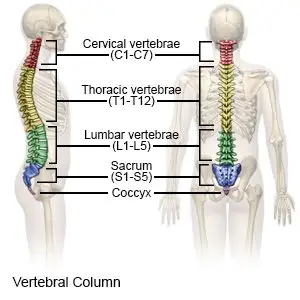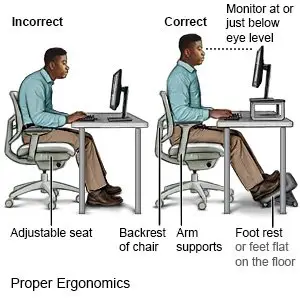What do I need to know about neck pain?
You may have sudden neck pain that increases quickly. You may instead feel pain build slowly over time. Neck pain may go away in a few days or weeks, or it may continue for months. The pain may come and go, or be worse with certain movements. The pain may be only in your neck, or it may move to your arms, back, or shoulders. You may also have pain that starts in another body area and moves to your neck. Some types of neck pain are permanent.
 |
What causes or increases my risk for neck pain?
- Stenosis (narrowing) of your spinal column, or degeneration (breakdown) or inflammation of the discs in your neck
- Inflammation from a condition such as rheumatoid arthritis, polymyalgia rheumatica, or rotator cuff tendinitis
- A condition that affects neck to arm nerves, such as thoracic outlet syndrome or brachial neuritis
- Trauma or injury to your neck, such as being hit from behind in a car (whiplash) or sleeping in a bad position
- A fracture of a neck bone that causes nerve damage
- A medical condition, such as shingles, meningitis, a tumor, or coronary artery disease (CAD)
How is the cause of neck pain diagnosed?
Your healthcare provider will ask about your symptoms and when they began. Tell your provider if you were recently in an accident or had another injury to your neck. Your provider will examine your neck and shoulders. You may move your head and arms in certain ways to see if any position causes or relieves the pain.
- Blood tests may be used to measure the amount of inflammation or to check for signs of an infection.
- X-ray or MRI pictures may show a neck injury or medical condition. Do not enter the MRI room with anything metal. Metal can cause serious damage. Tell the healthcare provider if you have any metal in or on your body.
How is neck pain treated?
Treatment will depend on what is causing your pain.
- Medicines may be prescribed or recommended by your healthcare provider for pain. You may need medicine to treat nerve pain or to stop muscle spasms. Medicines may also be given to reduce inflammation. Your healthcare provider may inject medicine into a nerve to block pain. Over-the-counter NSAID medicine or acetaminophen may be recommended to help treat minor pain or inflammation.
- Traction is used to relieve pressure from nerves. Your head is gently pulled up and away from your neck. This stretches muscles and ligaments and makes more room for the spine. Your healthcare provider will tell you the kind of traction that will help your neck pain. Do not use traction devices at home unless directed by your healthcare provider.
- Surgery may be needed if the pain is severe or other treatments do not work. Surgery will not help every kind of neck pain. You may need surgery to stabilize a fractured bone or to remove a tumor. Surgery may also be used to widen a narrowed spinal column or to remove a disc from between neck bones.
Treatment options
The following list of medications are in some way related to or used in the treatment of this condition.
- ibuprofen
- naproxen
- Aleve
- acetaminophen
- Advil
View more treatment options
What can I do to manage or prevent neck pain?
- Rest your neck as directed. Do not make sudden movements, such as turning your head quickly. Your healthcare provider may recommend you wear a cervical collar for a short time. The collar will prevent you from moving your head. This will give your neck time to heal if an injury is causing your neck pain. Ask your provider when you can return to sports or other normal daily activities.
- Apply heat as directed. Heat helps relieve pain and swelling. Use a heat wrap, or soak a small towel in warm water. Wring out the extra water. Apply the heat wrap or towel for 20 minutes every hour, or as directed.
- Apply ice as directed. Ice helps relieve pain and swelling, and can help prevent tissue damage. Use an ice pack, or put ice in a bag. Cover the ice pack or back with a towel before you apply it to your neck. Apply the ice pack or ice for 15 minutes every hour, or as directed. Your provider can tell you how often to apply ice.
- Do neck exercises as directed. Neck exercises help strengthen the muscles and increase range of motion. Your provider will tell you which exercises are right for you. The provider may give you instructions or may recommend that you work with a physical therapist. Your provider or therapist can make sure you are doing the exercises correctly.
- Maintain good posture. Try to keep your head and shoulders lifted when you sit. If you work in front of a computer, make sure the monitor is at the right level. You should not need to look up down to see the screen. You should also not have to lean forward to be able to read what is on the screen. Make sure your keyboard, mouse, and other computer items are placed where you do not have to extend your shoulder to reach them. Get up often if you work in front of a computer or sit for long periods of time. Stretch or walk around to keep your neck muscles loose.

When should I seek immediate care?
- You have an injury that causes neck pain and shooting pain down your arms or legs.
- Your neck pain suddenly becomes severe.
- You have neck pain along with numbness, tingling, or weakness in your arms or legs.
- You have a stiff neck, a headache, and a fever.
When should I contact my healthcare provider?
- You have new or worsening symptoms.
- Your symptoms continue even after treatment.
- You have questions or concerns about your condition or care.
Care Agreement
You have the right to help plan your care. Learn about your health condition and how it may be treated. Discuss treatment options with your healthcare providers to decide what care you want to receive. You always have the right to refuse treatment. The above information is an educational aid only. It is not intended as medical advice for individual conditions or treatments. Talk to your doctor, nurse or pharmacist before following any medical regimen to see if it is safe and effective for you.© Copyright Merative 2023 Information is for End User's use only and may not be sold, redistributed or otherwise used for commercial purposes.




